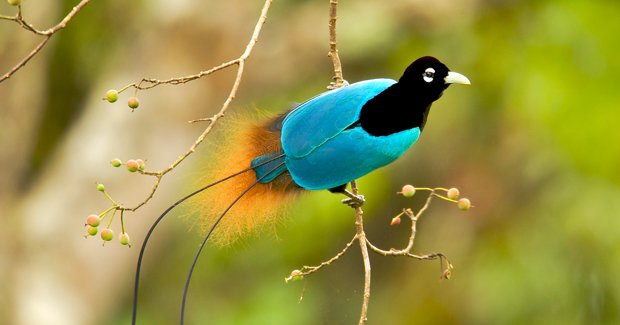Birds of paradise: ritual of seduction

THE CURIOUS BOBBING, FLAPPING and weaving displays of birds of paradise have enthralled twitchers for decades. These avian theatrics are performed by more than three dozen species, found mostly in rainforest regions of New Guinea, Indonesia and northern Australia.
The extravagant dancing and elaborate costumes are a mating strategy used by the brightly coloured males to display their virility to females. The aim is to attract as many females as possible in order to sire many offspring says Dr Walter Boles, bird collections officer at the Australian Museum in Sydney.
“Things are exaggerated – it’s like a cold war, where everyone is competing, trying to have that little bit more than everyone else,” he says. “The females tend to breed with the flashiest males, so there’s a premium for an increasingly flashy displays.”
The Australian Museum is next week launching an exhibition about birds of paradise and the people who share their lush rainforest habitat in New Guinea.
Birds of paradise: Dance of seduction
The exuberant displays are characteristic of most bird groups that are ‘polygynous’, including the birds of paradise. Polygynous means that promiscuous males attempt to mate with more than one female in each breeding cycle. And to attract females, and out-compete other males, they require extremely flashy features. After mating, the female bird of paradise is left to incubate the eggs and raise the chicks on her own.
Walter says the richness of their rainforest habitat – abundant in fruits and insects – reduces the males’ responsibility for providing for themselves and offspring, so they are able to spend the energy instead on bright decorations and mating displays.
“[The extravagance] really seems to say to females ‘look how much energy I have – it’s costing me a lot but I’m really fit and strong enough'”, Walter says.
The ornate plumage can even go so far as to impede a bird’s ability to fly. Some birds sport excessive trailing head plumes or tail feathers that make getting around the forest cumbersome. But the extra plumage can also be a message to females that the male is such hot stuff that he can navigate the forest despite the apparent handicap.
Birds of paradise mating rituals: Human comparisons
With few natural predators in their rainforest habitats, the birds of paradise have little to fear besides humans – and even with that threat, none are yet listed as endangered, though some, like the red bird of paradise, are near threatened.
This relatively predator-free environment has afforded the opportunity for elaborate performances to evolve. It is the resemblance between these performances and both ancient and modern human rituals that is the motivation behind the coming exhibition at the Australian Museum.
For centuries, the indigenous tribes of New Guinea have decorated their headdresses with feathers from birds of paradise. Some clans have adopted the movements of certain species, whose feathers and colours also adorn the tribes’ costumes in traditional rituals.
Yvonne Carrillo-Huffman, collections officer at the Australian Museum says there is still abundant evidence today of the cultural significance of the birds for New Guineans in traditional displays. “[Bird] plumes are highly regarded at such festivities, supporting and enhancing the strength, prosperity and collective beauty of each clan,” she says.
The exhibition, Rituals of Seduction: Birds Of Paradise will be held at the Melbourne Museum from 23 November, 2012 – 3 February, 2013.
VIDEO: Birds of Paradise with David Attenborough
RELATED STORIES

